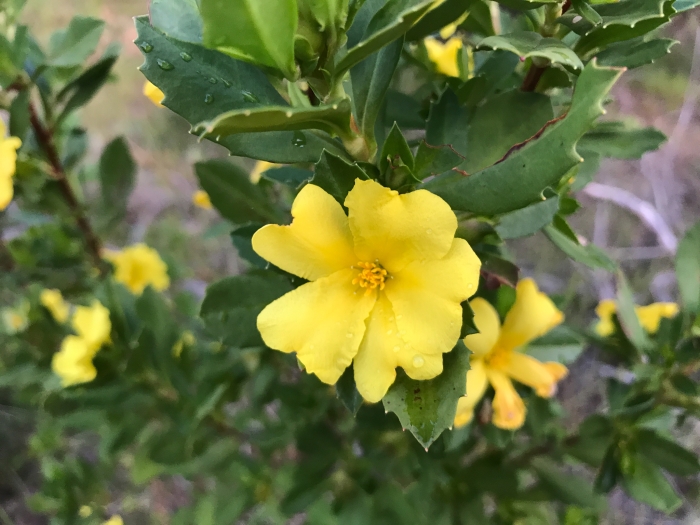Cut-Leaf Hibbertia
(Hibbertia cuneiformis)
Cut-Leaf Hibbertia (Hibbertia cuneiformis)
/
/

Cal Wood
CC BY 4.0
Image By:
Cal Wood
Recorded By:
Copyright:
CC BY 4.0
Copyright Notice:
Photo by: Cal Wood | License Type: CC BY 4.0 | License URL: http://creativecommons.org/licenses/by/4.0/ | Rights Holder: Cal Wood | Publisher: iNaturalist | Date Created: 2017-09-27T18:05:25-07:00 |































Estimated Native Range
Summary
Hibbertia cuneiformis, commonly known as Cut-leaf Hibbertia, is a species of erect or sprawling shrub native to the sandy and gravelly soils of open forests and coastal heaths in southwestern Australia. It typically grows to between 1 and 2 meters (3 feet 3 inches and 6 feet 7 inches) tall. The plant is characterized by its glossy green, wedge-shaped leaves and bright yellow, buttercup-like flowers that bloom in two distinct periods: January to March and June to November, depending on the local climate. The flowers are quite showy and attract a variety of pollinators.
Cut-leaf Hibbertia is valued for its vibrant yellow flowers and its adaptability to a range of garden settings. It is often used in native plant gardens, as a feature shrub in mixed borders, or for erosion control on slopes due to its sprawling habit. This shrub prefers well-drained soils, tolerates both full sun and part shade, and requires moderate watering, making it relatively easy to maintain. While it is not commonly afflicted by pests or diseases, it can be prone to root rot if overwatered or planted in poorly drained soils. It is not known to be invasive outside its native range, but as with all plants, gardeners should monitor its growth and spread.CC BY-SA 4.0
Cut-leaf Hibbertia is valued for its vibrant yellow flowers and its adaptability to a range of garden settings. It is often used in native plant gardens, as a feature shrub in mixed borders, or for erosion control on slopes due to its sprawling habit. This shrub prefers well-drained soils, tolerates both full sun and part shade, and requires moderate watering, making it relatively easy to maintain. While it is not commonly afflicted by pests or diseases, it can be prone to root rot if overwatered or planted in poorly drained soils. It is not known to be invasive outside its native range, but as with all plants, gardeners should monitor its growth and spread.CC BY-SA 4.0
Plant Description
- Plant Type: Shrub
- Height: 4-6 feet
- Width: 4-6 feet
- Growth Rate: Moderate
- Flower Color: Yellow
- Flowering Season: Spring, Summer
- Leaf Retention: Evergreen
Growth Requirements
- Sun: Full Sun, Part Shade
- Water: Medium
- Drainage: Medium
Common Uses
Bee Garden, Butterfly Garden, Low Maintenance, Rock Garden, Showy Flowers, Street Planting
Natural Habitat
Sandy and gravelly soils of open forests and coastal heaths in southwestern Australia
Other Names
Common Names:
Scientific Names: , Hibbertia cuneiformis, Candollea cuneiformis, Hibbertia tetrandra, Candollea tetrandra, Hibbertia obcuneata, Candollea calycina, Candollea latifolia, Hibbertia obcuneifolia,
GBIF Accepted Name: Hibbertia cuneiformis (Labill.) Sm.